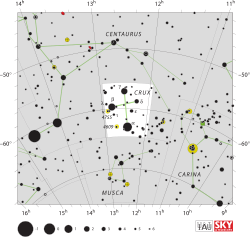DL Crucis
| DL Crucis | |
 | |
| Observationsdata Epok: J2000.0 | |
|---|---|
| Stjärnbild | Södra korset |
| Rektascension | 12t 14m 16,9255s[1] |
| Deklination | -64° 24′ 30,622″[1] |
| Skenbar magnitud () | 6,18[2] |
| Stjärntyp | |
| Spektraltyp | B1.5 Ia[3] |
| U–B | -0,73[2] |
| B–V | +0,12[2] |
| Variabeltyp | Alfa Cygni-variabel[4] |
| Astrometri | |
| Radialhastighet () | -10,50[5] km/s |
| Egenrörelse (µ) | RA: -5,62[1] mas/år Dek.: -1,162[1] mas/år |
| Parallax () | 0,80 ± 0,30[6] |
| Avstånd | ca 4 000 lå (ca 1 300 pc) |
| Absolut magnitud () | -6,9[7] |
| Detaljer | |
| Massa | 30[3] M☉ |
| Radie | 42[7] R☉ |
| Luminositet | 251 000[7] L☉ |
| Temperatur | 20 100[3] K |
| Vinkelhastighet | 43[3] km/s |
| Andra beteckningar | |
| HD 106343, ALS 14198, CD-63 732, CEL 4073, CPD-63 2203, GSC 08982-04743, HIC 59678, HIP 59678, HR 4653, 2MASS J12141690-6424304, PPM 359268, SAO 251803, TYC 8982-4743-1, uvby98 100106343, DL Crucis, Gaia DR2 6053289871533720448, Gaia DR3 6053289871533720448[8] | |
DL Crucis eller HD 106343, är en ensam stjärna belägen i södra delen av stjärnbilden Södra korset i närheten av Alfa Crucis och nebulosan Kolsäcken. Den har en skenbar magnitud av ca 6,2[2] och är mycket svagt synlig för blotta ögat där ljusföroreningar ej förekommer.[9] Baserat på parallax enligt Gaia Data Release 1 på ca 0,80 mas[2] beräknas den befinna sig på ett avstånd av ca 4 000 ljusår (ca 1 300[7][9] parsec) från solen. Den rör sig närmare solen med en heliocentrisk radialhastighet av ca -10 km/s.[5]
Observation
[redigera | redigera wikitext]År 1977 användes DL Crucis, då kallad HR 4653, som en jämförelsestjärna för att testa variabiliteten av Delta Crucis. Delta Crucis visade sig vara konstant i förhållande till flera andra stjärnor, men skillnaden i ljusstyrka mellan den och HR 4653 ändrades med 0,02 magnitud.[10] Den ansågs sannolikt vara en variabel med en längre period än sju timmar.[11]
Egenskaper
[redigera | redigera wikitext]
DL Crucis är en blå ljusstark superjättestjärna av spektralklass B1.5 Ia.[3] Den har en massa av ca 30[3] solmassor, en radie av ca 42[7] solradier och utsänder energi från dess fotosfär motsvarande ca 251 000[7] gånger solen vid en effektiv temperatur av ca 20 100[3] K. Hipparcos fotometri visar att DL Crucis varierar med upp till 0,04 magnitud med en huvudperiod på 2 dagar 21 timmar. Den klassificerades som en Alfa Cygni-variabel.[13] Kort därefter fick den variabelbeteckningen DL Crucis.[14] En senare detaljerad statistisk analys av samma data fann perioder på 3,650 och 3,906 dygn och en första harmonisk pulsering, med ett maximalt ljusstyrkeområde på 0,11 magnitud.[7]
Referenser
[redigera | redigera wikitext]- Den här artikeln är helt eller delvis baserad på material från engelskspråkiga Wikipedia, DL Crucis, 22 augusti 2024.
Noter
[redigera | redigera wikitext]- ^ [a b c d] Van Leeuwen, F. (2007). "Validation of the new Hipparcos reduction". Astronomy and Astrophysics. 474 (2): 653–664. arXiv:0708.1752. Bibcode:2007A&A...474..653V. doi:10.1051/0004-6361:20078357. S2CID 18759600.
- ^ [a b c d e] Schild, R. E.; Garrison, R. F.; Hiltner, W. A. (1983). "UBV photometry for southern OB stars". The Astrophysical Journal Supplement Series. 51: 321. Bibcode:1983ApJS...51..321S. doi:10.1086/190852. ISSN 0067-0049.
- ^ [a b c d e f g] Fraser, M.; Dufton, P. L.; Hunter, I.; Ryans, R. S. I. (2010). "Atmospheric parameters and rotational velocities for a sample of Galactic B-type supergiants". Monthly Notices of the Royal Astronomical Society. 404 (3): 1306. arXiv:1001.3337. Bibcode:2010MNRAS.404.1306F. doi:10.1111/j.1365-2966.2010.16392.x. ISSN 0035-8711. S2CID 118674151.
- ^ Samus, N. N.; Durlevich, O. V.; et al. (2009). "VizieR Online Data Catalog:General Catalogue of Variable Stars (Samus+ 2007–2013)". VizieR On-line Data Catalog. 1: 02025. Bibcode:2009yCat....102025S.
- ^ [a b] Gontcharov, G. A. (2006). "Pulkovo Compilation of Radial Velocities for 35 495 Hipparcos stars in a common system". Astronomy Letters. 32 (11): 759–771. arXiv:1606.08053. Bibcode:2006AstL...32..759G. doi:10.1134/S1063773706110065. ISSN 1063-7737. S2CID 119231169.
- ^ Gaia Collaboration (2016). "VizieR Online Data Catalog: Gaia DR1 (Gaia Collaboration, 2016)". VizieR On-line Data Catalog. 1337. Bibcode:2016yCat.1337....0G. doi:10.26093/cds/vizier.1337.
- ^ [a b c d e f g] Lefever, K.; Puls, J.; Aerts, C. (2007). "Statistical properties of a sample of periodically variable B-type supergiants. Evidence for opacity-driven gravity-mode oscillations". Astronomy and Astrophysics. 463 (3): 1093. arXiv:astro-ph/0611484. Bibcode:2007A&A...463.1093L. doi:10.1051/0004-6361:20066038. S2CID 8783008.
- ^ https://simbad.cds.unistra.fr/simbad/sim-id?Ident=DL+Cru. Hämtad 2024-10-18.
- ^ [a b] Bortle, John E. (February 2001). "The Bortle Dark-Sky Scale". Sky & Telescope. Sky Publishing Corporation. Retrieved 28 June 2014.
- ^ Balona, L. A. (1977). "A search for Beta Canis Majoris stars". Memoirs of the Royal Astronomical Society. 84: 101. Bibcode:1977MmRAS..84..101B.
- ^ Jakate, S. M. (1979). "A search for Beta Cephei stars. III - Photometric studies of southern B-type stars". Astronomical Journal. 84: 552. Bibcode:1979AJ.....84..552J. doi:10.1086/112448.
- ^ "Hipparcos Tools Interactive Data Access". Hipparcos. ESA. Hämtad 8 december 2021.
- ^ Waelkens, C.; Aerts, C.; Kestens, E.; Grenon, M.; Eyer, L. (1998). "Study of an unbiased sample of B stars observed with Hipparcos: The discovery of a large amount of new slowly pulsating B stars". Astronomy and Astrophysics. 330: 215. Bibcode:1998A&A...330..215W.
- ^ Kazarovets, E. V.; Samus, N. N.; Durlevich, O. V.; Frolov, M. S.; Antipin, S. V.; Kireeva, N. N.; Pastukhova, E. N. (1999). "The 74th Special Name-list of Variable Stars". Information Bulletin on Variable Stars. 4659: 1. Bibcode:1999IBVS.4659....1K.
Externa länkar
[redigera | redigera wikitext]
| |||||||||||||||||||




